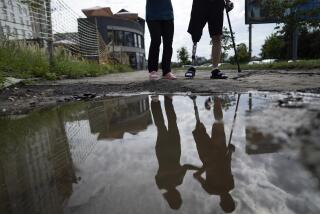Recycled Artificial Limbs Aid Third World Amputees
- Share via
ESSEX JUNCTION, Vt. — Dan and Sue Hebert recycle all the usual household items: bottles, cans, newspapers, cardboard.
But now they’ve brought their recycling spirit to work as well, and that’s where things get a little more unusual.
As owners of Bio-Medical Appliances Inc., which makes artificial limbs, the Heberts were concerned about the growing piles of used arms and legs lying around their business.
People need to be fitted for new ones every couple of years as their bodies change, Sue Hebert explained. Or, when they die, their loved ones are left wondering what to do with the limbs they used.
“I just hated to see all this good stuff going to the landfill,” said Dan Hebert, pointing to a shelf loaded with feet, ankles and shins at his modest shop.
So the Heberts contacted the Leg Bank, a Miami-based organization they found in a prosthetics trade journal. That group collects used artificial limbs from wherever it can get them, shipping most to Latin America.
Another group, the Wilmington-based Vets With a Mission, sends artificial limbs and limb parts to Southeast Asia, the Heberts said. There they are used for amputees who can’t afford the artificial limbs that are common in this country. Often, especially in Southeast Asia, the amputees have lost limbs to land mines, the Heberts said.
There’s one problem with the recycling effort however: Nearly all of the estimated 1,000 amputees living in Vermont--the source of the recycled limbs--are adults, Mr. Hebert said. Many of the victims of land mines are children.
But to the extent they can help anyone, they want to. The Heberts said artificial limbs can run in price anywhere from $150 for the simplest foot to a more advanced ankle-foot combination for $3,000.
Even the least expensive prosthetics, if bought new, would be beyond the reach of many people living in the Third World. “Even this $150 foot, for someone who makes $150 a year, they can’t afford it,” Dan Hebert said.
For the Heberts, the recycling is a small sideline to a thriving business that makes artificial limbs from scratch and works with doctors and physical therapists to make sure they’re the right fit for patients in need.
The work combines a wide range of mechanical and craft know-how, said Tom LeVanway, who does much of the nuts-and-bolts work of building the firm’s prosthetic limbs.
LeVanway demonstrated a large, floor-model router that can be fitted with a variety of grinding wheels for shaping the materials--usually acrylic resins--that make up the outer layers of the limbs. Knowledge of the workings of titanium knee and ankle joints is also required.
There’s also a bit of art involved, particularly in trying to get the outer, visible portion of a leg just right, LeVanway said. “You’re replacing the body image. To have the prosthetic leg look as much as possible like the other leg is crucial,” he said.
After they lined up a place to send the used limbs, the Heberts submitted a small public service announcement to their local newspaper. A few days later, they were showing visitors around their shop when their first donation arrived.
Clare Stewart of Underhill, said her husband, John, who had diabetes, had been fitted for an artificial leg eight years ago. But despite physical therapy, he never mastered using it, and the leg sat in a closet.
“We were wondering for a long time, what good’s that thing doing in the closet?” Clare Stewart said. Of the notion that it might find a home helping a poor person walk, she said, “that makes me feel really good.”
More to Read
Sign up for Essential California
The most important California stories and recommendations in your inbox every morning.
You may occasionally receive promotional content from the Los Angeles Times.










